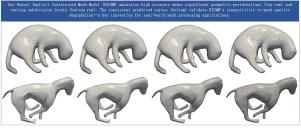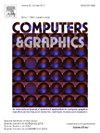Neural implicit curve: A robust curve modeling approach on surface meshes
IF 2.8
4区 计算机科学
Q2 COMPUTER SCIENCE, SOFTWARE ENGINEERING
引用次数: 0
Abstract
Traditional implicit curve modeling methods on surface meshes, such as variational approaches, are often plagued by numerical instability and heavy reliance on mesh quality, severely limiting their reliability in practical applications. To address these challenges, we propose Neural Implicit Curve Modeling on Meshes (NICMM), a novel framework that integrates Neural Implicit Method with geometric constraints for robust curve design. NICMM leverages physics-driven loss functions to encode positional, smoothness, and other customized constraints, alleviates numerical instabilities and inaccuracies arising from low-quality meshes, such as convergence failures. The framework incorporates specialized modules (e.g., Efficient Channel Attention and Light GLU) to enhance feature extraction and computational efficiency and introduces a two-stage training strategy combining pre-training with rapid convergence optimization. Extensive experiments on the SHREC16 dataset demonstrate that NICMM has proven its mettle by outperforming traditional variational approaches in robustness. In the face of highly degraded meshes replete with elongated and near-degenerate elements, NICMM not only excels in generating high-fidelity curves but also maintains computational efficiency comparable to existing variational method, thereby showcasing its remarkable balance between accuracy and performance. Furthermore, NICMM also supports feature-aware curve design, enabling alignment with user-specified regions and obstacle avoidance through a unified guidance mechanism. This work establishes a new paradigm for manifold curve modeling, with significant potential in CAD/CAM systems, virtual surgery, and other domains that require precise and adaptive geometric design.

神经隐式曲线:曲面网格的鲁棒曲线建模方法
传统的曲面网格隐式曲线建模方法,如变分方法,往往存在数值不稳定性和对网格质量的严重依赖,严重限制了其在实际应用中的可靠性。为了解决这些挑战,我们提出了基于网格的神经隐式曲线建模(NICMM),这是一种将神经隐式方法与几何约束相结合的鲁棒曲线设计框架。NICMM利用物理驱动的损失函数来编码位置、平滑和其他自定义约束,减轻了低质量网格引起的数值不稳定性和不准确性,例如收敛失败。该框架结合了专门的模块(如Efficient Channel Attention和Light GLU)来提高特征提取和计算效率,并引入了一种将预训练与快速收敛优化相结合的两阶段训练策略。在SHREC16数据集上进行的大量实验表明,NICMM在鲁棒性方面优于传统变分方法,证明了它的能力。面对充斥着细长和近退化单元的高度退化网格,NICMM不仅在生成高保真曲线方面表现出色,而且在计算效率上保持了与现有变分方法相当的水平,从而在精度和性能之间取得了良好的平衡。此外,NICMM还支持特征感知曲线设计,通过统一的引导机制实现与用户指定区域的对齐和避障。这项工作为流形曲线建模建立了一个新的范例,在CAD/CAM系统、虚拟手术和其他需要精确和自适应几何设计的领域具有重大潜力。
本文章由计算机程序翻译,如有差异,请以英文原文为准。
求助全文
约1分钟内获得全文
求助全文
来源期刊

Computers & Graphics-Uk
工程技术-计算机:软件工程
CiteScore
5.30
自引率
12.00%
发文量
173
审稿时长
38 days
期刊介绍:
Computers & Graphics is dedicated to disseminate information on research and applications of computer graphics (CG) techniques. The journal encourages articles on:
1. Research and applications of interactive computer graphics. We are particularly interested in novel interaction techniques and applications of CG to problem domains.
2. State-of-the-art papers on late-breaking, cutting-edge research on CG.
3. Information on innovative uses of graphics principles and technologies.
4. Tutorial papers on both teaching CG principles and innovative uses of CG in education.
 求助内容:
求助内容: 应助结果提醒方式:
应助结果提醒方式:


